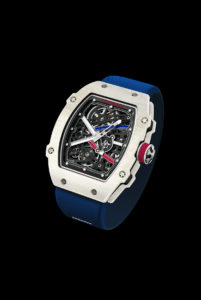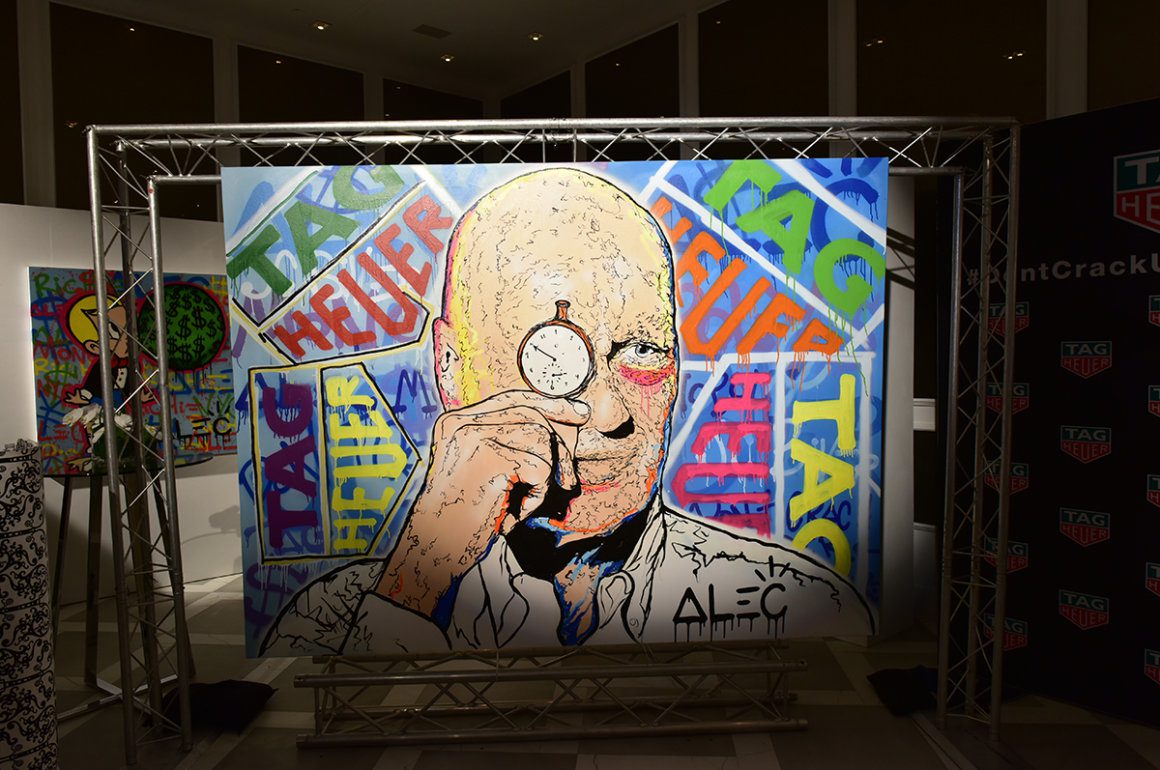
Olympian skier Alexis Pinturault, who was involved in designing the red, white and blue RM 67-02 Automatic
Irene Bellucci meets World-Cup-winning Alpine ski racer Alexis Pinturault and super-G skiing and giant slalom snowboarding Olympic gold medallist Ester Ledecká on the powdery slopes of Courchevel to talk winning, the thrill of the race and their roles as ambassadors for luxury watchmaker Richard Mille
Alexis Pinturault is France’s most successful skier, notching up 23 World Cup victories and representing his country in five World Championships and two Winter Olympics, most recently winning four bronze medals in the giant slalom event.
LUX: What does skiing mean to you?
Alexis Pinturault: Doing any kind of sport is a kind of mindset. It brings you education, respect, confidence. It is a way of life.
LUX: Are you very competitive?
Alexis Pinturault: Yes, maybe too much, but I am getting better. It’s important to know your competitors, but on the day of the race, there is just you. I try to be more accepting about losing, but I used to find it very difficult. Alpine skiers are a bit crazy.
Follow LUX on Instagram: luxthemagazine

RM 67-02 Automatic
LUX: Describe a typical training day for you.
Alexis Pinturault: I wake up at 6 or 6.30, warm up and have breakfast. I’ll be on the slopes by 7.30 for an inspection at 8.30, and take my first run at 9.30. Depending on the results, we might go ahead with a second inspection and run. We’ll then have a break, review progress and then I might have some physiotherapy. On the rare day that I’m not training, I’m not very patient. My wife and I are very active: we go hiking, diving, walking. Never just chilling on the beach.
LUX: What do you feel just before the start of the race?
Alexis Pinturault: I’m very focused on the moment. When I’m skiing, it’s all about instinct and I don’t have time to think about what I’m doing. If you start to think about it, the race is already over. When we are racing, we are like animals.
LUX: What do you consider “success”?
Alexis Pinturault: Success is an achievement. For a sportsman, it’s reaching a goal, like the Olympics. But even once you’ve achieved your goal, there are always other goals to reach for.
LUX: What are your other goals for the next five years?
Alexis Pinturault: I want to win the World Championship here in Courchevel in 2023, and then maybe the next Olympics in 2026.
LUX: Do you feel pressure to set an example for the next generation of skiers?
Alexis Pinturault: You do feel pressure when you spot all the kids and all the people cheering for you at the finish line, waiting for autographs and selfies and wanting to spend time with you. But it’s amazing to come back to Courchevel and ski with the kids from the ski club.
Read more: Inside Andermatt’s newly opened concert hall
LUX: Are you a watch enthusiast?
Alexis Pinturault: Yes. I got my first watch from my grandfather, and another one after I got married.
LUX: Do you wear your Richard Mille watch during competitions?
Alexis Pinturault: Yes, it’s lightweight and I wear it under gloves and a protector for slalom and giant slalom races. I was involved in designing some of the details and suggested white for snow, and red and blue to represent the French flag.
LUX: Is there a connection between the brand and your sport?
Alexis Pinturault: Yes – we are both focused on pushing the limits, always looking and trying new ideas.

Olympian skier Ester Ledecká
At the 2018 Winter Olympic Games in PyeongChang, South Korea, Ester Ledecká triumphed in both the super-G Alpine skiing event and the giant slalom in snowboarding. This feat made the Czech athlete the first person to win gold in two separate disciplines at the same Winter Olympics.
LUX: Can you describe the feeling of skiing downhill?
Ester Ledecká: Pure freedom. When I ride down the hills, I can feel little fireworks inside my heart. The feeling is even stronger when I’m competing! Everyone asks me, “How are you going to celebrate after the race?” and I always reply that I have already celebrated. Nothing better can happen after the run because I’ve already experienced the best feeling in the world.
LUX: Why do you do both snowboarding and skiing?
Ester Ledecká: For me, this is an easy question to answer. It’s because I love both of them too much! I don’t want to be bored by either of them.
LUX: How do you win races across both disciplines?
Ester Ledecká: There is no tutorial for it. I worked hard, I started when I was two years old and I have trained every day for 22 years. It takes a lot of training, and you need to learn how to lose – billions of times – before you reach some kind of result.
Read more: Spring Studios Founder Francesco Costa on creative networking
LUX: What is your relationship with time?
Ester Ledecká: Actually, I am in a race with time. I don’t race with other girls, I race with time. It doesn’t matter if it’s snowboarding or skiing. It doesn’t matter who’s next to me. I just need to be fast.

RM67-02
LUX: Does your Richard Mille watch help?
Ester Ledecká: Richard Mille gave me my first watch. The design of these watches is all about precision and details. There are no excuses; everything needs to be perfect. I love the way you can see all the details inside the dial; other brands hide the workings of the watch, but Richard Mille’s are perfect. When I met the Richard Mille ‘family’, I fell in love with the whole team. This watch is much more than a pretty thing I have on my wrist, it’s a reminder that I’m part of something very big. The company supports me not as a sponsor, but like a real family. They are with me if I win or if I lose. When I’m wearing my watch, I remember that someone’s got my back.
LUX: Do you wear the watch during the competitions?
Ester Ledecká: Sadly no, because it doesn’t fit under my suit and protection for downhill and super-G. But I can wear it to play other sports because it’s so light.
LUX: Who else supports your career?
Ester Ledecká: I am lucky to come from a very supportive family. My grandpa [Jan Klapáč] was a world champion in ice hockey and he taught me how to love sport and how to lose. He showed me how beautiful and fun a professional sport can be. To become a professional athlete you need a lot of passion. You have to sacrifice a lot, including your personal life. It’s a tough job, but he taught me how to love even the hardest parts of my job. My mum also comes with me everywhere, she’s never missed a race – apart from one on the other side of the ocean because she is afraid to fly.
LUX: What are your future goals now that you’ve already won so much?
Ester Ledecká: I haven’t won anything at all, I am just at the beginning. There is a long way in front of me. Even in snowboarding, there is still something to improve. I still have a lot of races to win in skiing. That will take a long time, but step by step…
LUX: Can you describe Alexis?
Ester Ledecká: Fast. Cute. And one of my skiing idols.
Thank you to the Hôtel Annapurna in Courchevel, owned by Pinturault’s family, for hosting LUX. For more information visit: annapurna-courchevel.com
This article was originally published in the Autumn 19 Issue.












Recent Comments